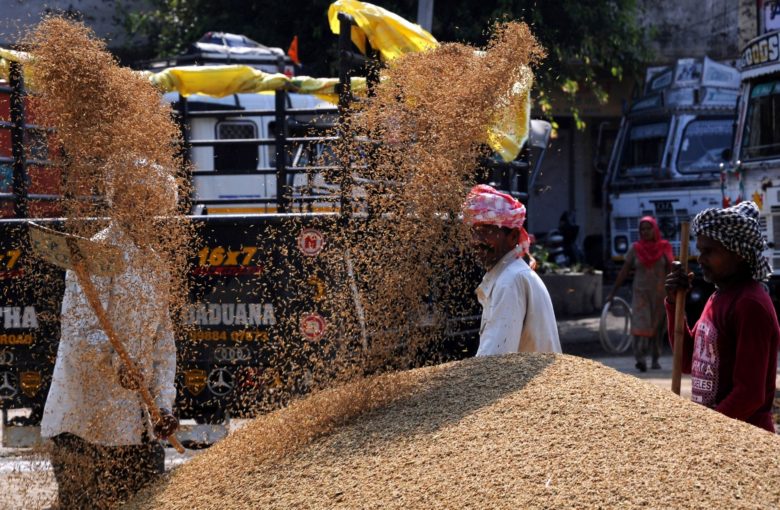New Delhi: Even though India’s wheat exports were robust in FY22, riding on a possible supply disruption of foodgrains — especially wheat — as the tensions between Russia and Ukraine turned into a full-blown war, export demand has got a fresh push.
The stumbling block, though, is the traditional opposition from western nations within the World Trade Organisation (WTO) to wheat exports from India because they consider the Minimum Support Price for food grains guaranteed by the government a subsidy that goes against the principles upheld by the WTO.
Both the countries involved in the ongoing war are major producers of wheat. India produces surplus foodgrains and the fresh export demand won’t put inflationary pressure on their prices in the country.
To put matters in perspective, India’s wheat exports during April-December 2021 were pegged at 5.04 million tonnes, against 1.06 million tonnes during the same period in 2020, and the offtake is expected to rise further in the fourth quarter, riding on record food grain production.
On February 16, 2022, the Agriculture Ministry announced that India was poised to produce 111.32 million tonnes of wheat, which is a record in itself. The overall estimate for foodgrains is 316.06 million tonnes, again a record.
In 2021, wheat production stood at 109.24 million tonnes, while overall food grains production was estimated at 303.34 million tonnes.
India is the second largest producer of wheat with a share of around 13.53 per cent of world’s total production, but the major chunk of the production goes towards domestic consumption.
India, incidentally, has been the world’s top rice exporter. Wheat exports have also seen a 48.56 per cent compounded annual growth rate (CAGR) between 2016 and 2020, touching US$243 million in 2020, against US$50 million in 2016, according to data in the ITC Trade Map 2021.
Still, India accounts for even less than one per cent of world wheat exports, though its share has increased from 0.14 per cent in 2016 to 0.54 per cent in 2020. Now, the disruption of supplies from Russia and Ukraine has opened a window of opportunity for India’s wheat exports to touch a record high.
The wheat that is exported is all channeled by private traders. With the opening of this new window, if India were to sell off its excess stock from government storage facilities, it may come up against the opposition of western nations.
“Under the WTO framework, if wheat is exported from out of the stocks procured under MSP, it is considered a violation of the public stock holding agreement,” said Devinder Sharma, an expert on agricultural issues.
“India gets to subsidise — the western nations call our MSP procurement a subsidy — only for the nutritional and food security requirements of Indians. We can procure and store for our consumption, but not export out of it, is what they claim,” Sharma added.
Fresh export queries, meanwhile, have led wheat prices to hit a record high in India. In Indore, Madhya Pradesh, considered to be one of the benchmark markets for the grain, wheat is being sold now at Rs 2,400-2,500 per quintal (100 kg), against Rs 2,000-2,1000 until the war broke out.
In the US market too, futures prices of wheat rose in a range of 40-50 per cent in the past one-month, which in a way is one more reason for Indian wheat to become attractive.
The demand from exporters is heavy apparently because of the talk that the supply line from Russia and Ukraine may dry up if the tensions persist.
Normally, prices of wheat remain on the lower side during this time of the year as freshly harvested rabi crops make their way into the physical markets — mandis.
The current wheat price in India is well above the Centre’s Minimum Support Price (MSP), which is a rare phenomenon. The MSP for wheat for the 2022-23 marketing season has been fixed at Rs 2,015 per quintal.
When wheat prices rise above MSP, it essentially means that the Centre will have to purchase lesser quantities under the price guarantee scheme as the farmers are already getting premium realisation for their produce from private buyers.
Analysts also believe that stepped-up wheat exports will also address the chronic problem of rampant wastage in government-owned storage facilities managed by the Food Corporation of India (FCI).
The government dutifully procures huge quantities of food grains under the Minimum Support Price (MSP) scheme. But it is no secret that an enormous amount of these procured grains are wasted in government holdings because these are not stored properly.
In the absence of proper storage — known in the trade as CAP, or the cover and plinth method — FCI, which procures grains from across India, stores the acquisitions in open grounds under tarpaulin covers. Exposed to the elements, especially thunderstorms and sometimes floods, several such sites see enormous quantities of procured wheat being wasted.
Under Open Market Sales Scheme (Domestic) [OMSS(D)], FCI sells excess stock of foodgrains out of the Central Pool in the open market at pre-determined prices, explained a government official. He added: “The prices and the quantity of foodgrains that are to be offloaded under the OMSS (D) are decided by the government taking into consideration MSP, economic cost, procurement incidentals, surplus stocks, and so on.”
It is not immediately known how much quantity has been released under the Central Pool in the open market since the war broke out last month. “But everyone would like to make hay while the sun shines, so there is definitely a possibility that the government will want to sell off its excess stocks,” Sharma said. “And it will wriggle out of WTO provisions citing the global emergency and the need to stabilise food prices,” he added.
(IANS)




















